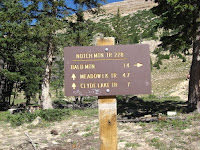While age has restricted my hiking abilities to some extent, I recently took a trip to The Canadian Rockies and enjoyed a hike that was not too difficult. The areas around Banff, Lake Louise, and Moraine Lake offer some of the most breathtaking scenery on the planet. Consequently, its popularity has increased dramatically over the years with large crowds of tourists, congested parking areas, and Parks Canada making concerted efforts to keep things under control. Just west of Lake Louise lies a smaller, more tranquil lake known as Lake Agnes – named for the original First Lady of Canada, Lady Agnes MacDonald. In 1901 the Canadian Pacific Railway constructed a teahouse near the northeast shore of the lake as a resting stop for hikers – complete with an interior shelter. Since 1905, it has served a variety of teas, hot drinks, homemade soups, sandwiches, and other snacks to weary visitors and hikers alike. I find it amazing that this eatery can function fully given that there is no electricity, running water, and access is only by horseback or on foot. Viewpoints of Lake Louise and the Bow Valley can be reached by hiking to The Big and Little Beehives, Devils Thumb, and other points not listed here.
To reach the Lake Louise Village, travel 183 kilometers (114 miles) west from Calgary, Alberta, or 83 kilometers (51 miles) east from Golden, British Columbia along the Trans-Canada Highway (Highway 1). Upon reaching the boundary of Banff National Park (or any other sites managed by Parks Canada), be prepared to stop and pay the necessary fees. When we entered, the daily prices (in CAD) were $10.50 for adult (18-64), $9.00 for senior (65 and over), and free for youth (17 and under). The only instance when free admission is granted is when the highway is being used as a route of travel only with no stops in the park. Keep in mind that these fees do not include parking and other fees that may be required. Once at the village, exit Highway 1 and drive west along Lake Louise Drive approximately 4.0 kilometers (2.5 miles) to the parking area just before the Chateau Lake Louise Hotel. Here things tend to get chaotic with attendants directing you, watching out for people, and trying to find a place to park. During our visit, it was $12.25 (CAD) per day to park your vehicle, which was not the case not many years earlier. Plan wisely if desiring to access the Moraine Lake parking area (free for now) – as it often fills up before 5:00am each day and is blocked off until about 7:00pm. While shuttle buses are available for transporting people in and out of these areas, the online booking process was a total nightmare when we attempted to use it. My feeling is that no one should have to book a spot on a shuttle bus! Luckily, we stayed at a hotel nearby, and I was able to walk a short distance to the trailhead.
 |
| The iconic view of Lake Louise from the Chateau Lake Louise Hotel |
 |
| Lake Agnes Tea House near the northeast shore of Lake Agnes |
 |
| Daily menu for the Lake Agnes Tea House |
 |
| View looking across Lake Agnes towards the teahouse |
































